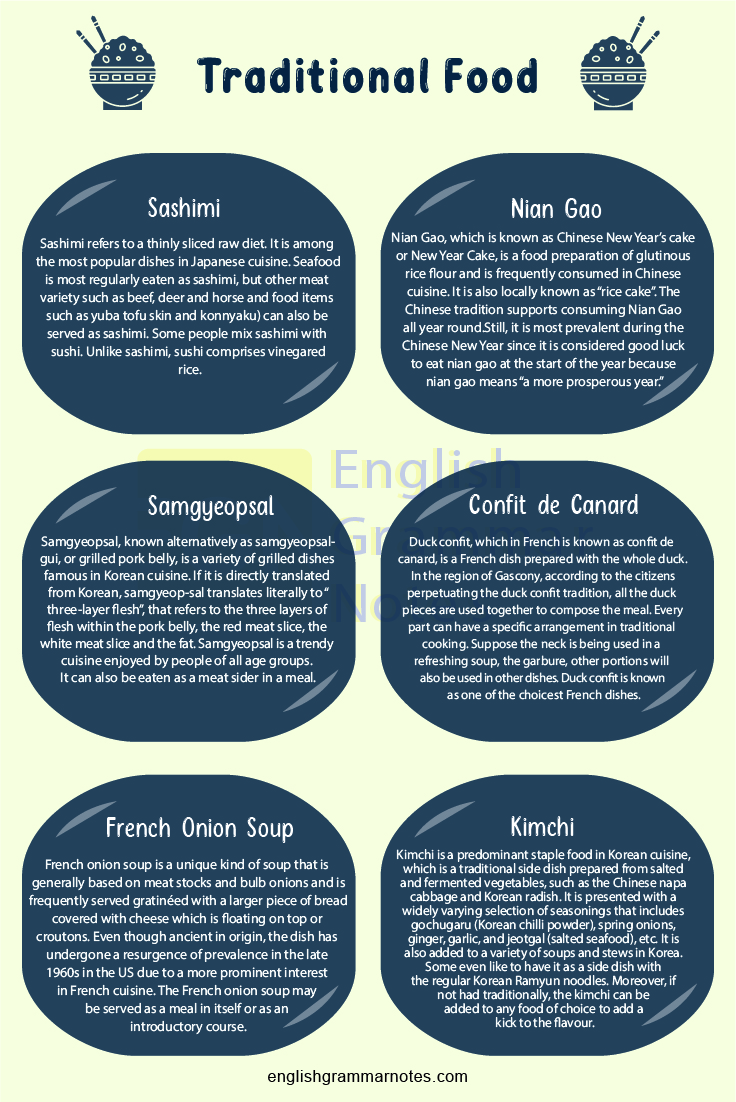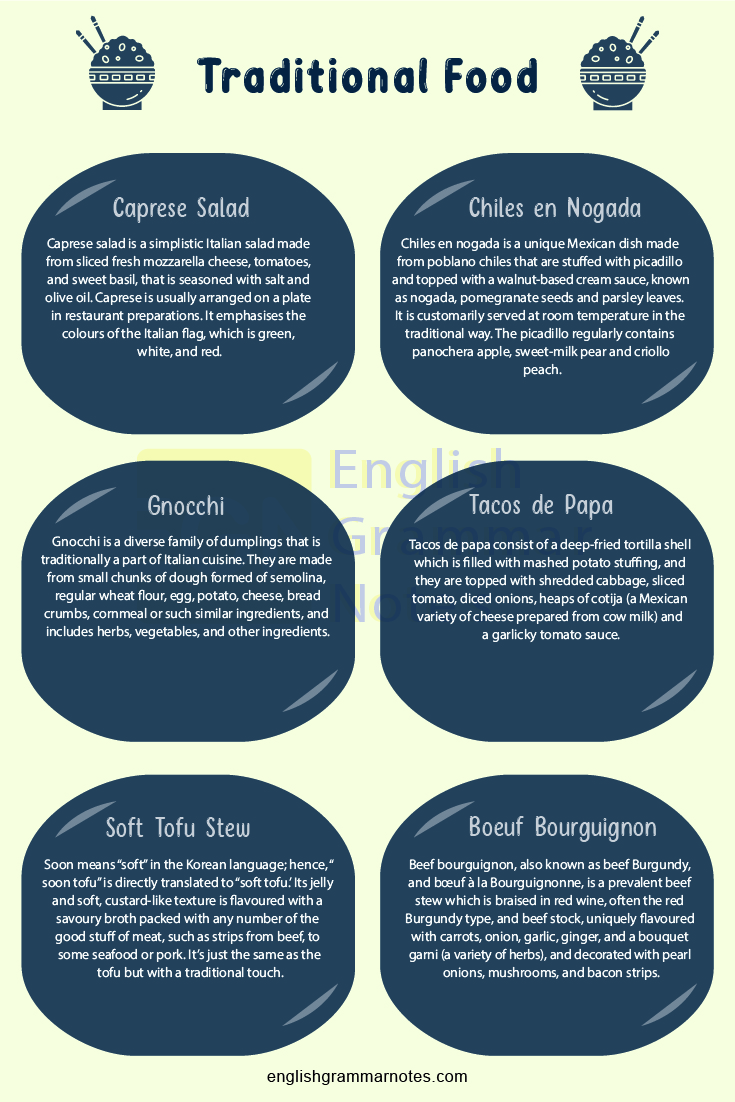Traditional Food: The world is divided into many countries, which have specialities of their own. Each country consists of its traditional delicacies, which makes their culture stand out, among others. Whether it’s using a unique ingredient, or inventing a unique way of preparation, or simply presentation, it takes a lot to consider a cuisine, any country’s trademark dish.
For foodies who love trying out various cuisines around the world or gain additional knowledge about signature dishes from around the world, and try out the best food in the world by country¸ can rely on this list of traditional food around the world to make up for a great multi cuisine dinner around the world.
Study the most important English Vocabulary Words identified by our experts and learn the right vocabulary to use in your day to day conversations
List of Traditional Food around the world
- Name of Traditional Food around the world
- Description of Traditional Food around the world on the List
Name of Traditional Food around the world
- List of Italian food to try
- List of Chinese food to try
- List of Korean food to try
- List of Mexican food to try
- List of French food to try
- List of Japanese food to try
Description of Traditional Food around the world on the List
List of Italian food to try
Caprese salad is a simplistic Italian salad made from sliced fresh mozzarella cheese, tomatoes, and sweet basil, that is seasoned with salt and olive oil. Caprese is usually arranged on a plate in restaurant preparations. It emphasises the colours of the Italian flag, which is green, white, and red.
Gnocchi is a diverse family of dumplings that is traditionally a part of Italian cuisine. They are made from small chunks of dough formed of semolina, regular wheat flour, egg, potato, cheese, breadcrumbs, cornmeal or such similar ingredients, and includes herbs, vegetables, and other ingredients.
Neapolitan pizza, alternatively known as the Naples-style pizza, is a pizza technique made with tomatoes and mozzarella cheese. We must make it with either Pomodorino del Piennolo del Vesuvio or San Marzano tomatoes when following the traditional recipe.
These tomatoes grow on the volcanic plains to the south of Mozzarella di Bufala Campana and Mount Vesuvius, an original protected cheese made with milk from water buffalo raised in the wetlands of Campania and Lazio in a semi-wild environment.
Neapolitan pizza is a cultural heritage that gave rise to the New York-style pizza first made by Italian immigrants in the United States as early as the twentieth century.
List of Chinese food to try
Congee which is also termed conjee is a kind of rice porridge or gruel consumed in Asian countries, especially China. When it is eaten as plain rice congee, it is mainly served with side dishes, and at times with additional ingredients such as meat, flavourings, and fish are added while preparing the congee.
In traditional China, it is most often served as a meal on its own, particularly for people who are ill; hence it is also termed as the ‘sick food’ in China. Names for congee are as diverse as the style of its preparation. But most primarily, it is usually a thick rice porridge largely dissolved after prolonged cooking in water.
Nian Gao, which is known as Chinese New Year’s cake or New Year Cake, is a food preparation of glutinous rice flour and is frequently consumed in Chinese cuisine. It is also locally known as “rice cake”. The Chinese tradition supports consuming Nian Gao all year round.
Still, it is most prevalent during the Chinese New Year since it is considered good luck to eat nian gao at the start of the year because nian gao means “a more prosperous year.”
Peking duck is a popular dish from the heart of Beijing that has been prepared since the Imperial era in China. The meat is defined by its thin, crispy skin, with authentic versions of the dish that primarily serve the skin and a small portion of meat, sliced in front of the diners by the cook.
Duck of a unique type are bred specially for the dish and are slaughtered after a total of 65 days. The duck is then seasoned before being roasted in a hung oven or a closed one. The meat is often consumed with spring onion, cucumbers, sweet red bean sauce, and pancakes rolled around the fillings.
While some eat this the traditional way, others like adding a little pickled radish on the inside and flavourings such as hoisin sauce.
List of Korean food to try
Kimchi is a predominant staple food in Korean cuisine, which is a traditional side dish prepared from salted and fermented vegetables, such as the Chinese napa cabbage and Korean radish.
It is presented with a widely varying selection of seasonings that includes gochugaru (Korean chilli powder), spring onions, ginger, garlic, and jeotgal (salted seafood), etc. It is also added to a variety of soups and stews in Korea. Some even like to have it as a side dish with the regular Korean Ramyun noodles.
Moreover, if not had traditionally, the kimchi can be added to any food of choice to add a kick to the flavour.

Soon means “soft” in the Korean language; hence, “soon tofu” is directly translated to “soft tofu.’ Its jelly and soft, custard-like texture is flavoured with a savoury broth packed with any number of the good stuff of meat, such as strips from beef, to some seafood or pork. It’s just the same as the tofu but with a traditional touch.
Samgyeopsal, known alternatively as samgyeopsal-gui, or grilled pork belly, is a variety of grilled dishes famous in Korean cuisine. If it is directly translated from Korean, samgyeop-sal translates literally to “three-layer flesh”, that refers to the three layers of flesh within the pork belly, the red meat slice, the white meat slice and the fat. Samgyeopsal is a trendy cuisine enjoyed by people of all age groups. It can also be eaten as a meat sider in a meal.
List of Mexican food to try
Chiles en nogada is a unique Mexican dish made from poblano chiles that are stuffed with picadillo and topped with a walnut-based cream sauce, known as nogada, pomegranate seeds and parsley leaves. It is customarily served at room temperature in the traditional way. The picadillo regularly contains panochera apple, sweet-milk pear and criollo peach.
Pozole, also known as Posole, is a dish from Nahuatl languages that means “Cacahuazintle” or ‘a variety of Corn or Maise’. It is a traditional soup or a light stew of traditional Mexican cuisine and is made from hominy with meat (typically pork, but sometimes replaced with chicken).
The dish is seasoned and garnished with shredded cabbage or lettuce, chili peppers, onion, ginger, garlic, radish, avocado, salsa or limes of a particular variety. It has been known as a prevalent dish in Mesoamerica since the pre-Columbian era, and in the present world, the stew is common across Mexico and its neighbouring countries, served both as a daily meal and as a festive dish.
Tacos de papa consist of a deep-fried tortilla shell that is filled with mashed potato stuffing, and they are topped with shredded cabbage, sliced tomato, diced onions, heaps of cotija (a Mexican variety of cheese prepared from cow milk) and a garlicky tomato sauce.
List of French food to try
Beef bourguignon, also known as beef Burgundy, and bœuf à la Bourguignonne, is a prevalent beef stew which is braised in red wine, often the red Burgundy type, and beef stock, uniquely flavoured with carrots, onion, garlic, ginger, and a bouquet garni (a variety of herbs), and decorated with pearl onions, mushrooms, and bacon strips.

Duck confit, which in French is known as confit de canard, is a French dish prepared with the whole duck. In the region of Gascony, according to the citizens perpetuating the duck confit tradition, all the duck pieces are used together to compose the meal. Every part can have a specific arrangement in traditional cooking.
Suppose the neck is being used in a refreshing soup, the garbure, other portions will also be used in other dishes. Duck confit is known as one of the choicest French dishes.
French onion soup is a unique kind of soup that is generally based on meat stocks and bulb onions and is frequently served gratinéed with a larger piece of bread covered with cheese which is floating on top or croutons.
Even though ancient in origin, the dish has undergone a resurgence of prevalence in the late 1960s in the US due to a more prominent interest in French cuisine. The French onion soup may be served as a meal in itself or as an introductory course.
List of Japanese food to try
Sashimi refers to a thinly sliced raw diet. It is among the most popular dishes in Japanese cuisine.
Seafood is most regularly eaten as sashimi, but other meat variety such as beef, deer and horse and food items such as yuba tofu skin and konnyaku) can also be served as sashimi. Some people mix sashimi with sushi. Unlike sashimi, sushi comprises vinegared rice.
Onigiri, which is also known as omusubi, nigirimeshi or rice ball, is a traditional Japanese food prepared from glutenous white rice shaped into triangular or cylindrical shapes and frequently wrapped in nori (Japanese seaweed).
Traditionally, an onigiri is stuffed with pickled umeboshi (pickled ume fruit, salted salmon, katsuobushi (stewed, smoked and fermented skipjack tuna), kombu (edible Japanese kelp), tarako (pollock roe), mentaiko sauce, takanazuke (pickled takana) or any such other sour or salty ingredient used as a natural preservative.
Most Japanese convenience stores are stocked with onigiri that has various fillings and flavours. There are even specific shops that only sell onigiri as take out. Due to the popularity of this course in Japan, onigiri has become a familiar staple in Japanese restaurants globally.
Sukiyaki which is commonly known as a Japanese dish, is prepared and served in the Japanese hot pot, nabemono style.
It consists of meat that is usually thinly sliced beef. It is slowly cooked or simmered at the table in a hotpot, alongside vegetables and other ingredients, in a shallow pot made of iron.
The meat is simmered in a mixture of soy sauce, Japanese mirin, and sugar. The ingredients are generally dipped in a small bowl of raw, beaten eggs after they have been cooked in the pot.
Generally, sukiyaki is a wintertime dish, and it is commonly seen at bōnenkai, which is Japanese year-end party.